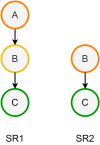LinChemIn: SynGraph-a data model and a toolkit to analyze and compare synthetic routes
- PMID: 37005691
- PMCID: PMC10067316
- DOI: 10.1186/s13321-023-00714-y
LinChemIn: SynGraph-a data model and a toolkit to analyze and compare synthetic routes
Abstract
Background: The increasing amount of chemical reaction data makes traditional ways to navigate its corpus less effective, while the demand for novel approaches and instruments is rising. Recent data science and machine learning techniques support the development of new ways to extract value from the available reaction data. On the one side, Computer-Aided Synthesis Planning tools can predict synthetic routes in a model-driven approach; on the other side, experimental routes can be extracted from the Network of Organic Chemistry, in which reaction data are linked in a network. In this context, the need to combine, compare and analyze synthetic routes generated by different sources arises naturally.
Results: Here we present LinChemIn, a python toolkit that allows chemoinformatics operations on synthetic routes and reaction networks. Wrapping some third-party packages for handling graph arithmetic and chemoinformatics and implementing new data models and functionalities, LinChemIn allows the interconversion between data formats and data models and enables route-level analysis and operations, including route comparison and descriptors calculation. Object-Oriented Design principles inspire the software architecture, and the modules are structured to maximize code reusability and support code testing and refactoring. The code structure should facilitate external contributions, thus encouraging open and collaborative software development.
Conclusions: The current version of LinChemIn allows users to combine synthetic routes generated from various tools and analyze them, and constitutes an open and extensible framework capable of incorporating contributions from the community and fostering scientific discussion. Our roadmap envisages the development of sophisticated metrics for routes evaluation, a multi-parameter scoring system, and the implementation of an entire "ecosystem" of functionalities operating on synthetic routes. LinChemIn is freely available at https://github.com/syngenta/linchemin.
Keywords: Chemoinformatics; Computer-aided synthesis planning; Reaction.
© 2023. The Author(s).
Conflict of interest statement
The authors declare that they have no competing interests.
Figures









Similar articles
-
LinChemIn: Route Arithmetic─Operations on Digital Synthetic Routes.J Chem Inf Model. 2024 Mar 25;64(6):1765-1771. doi: 10.1021/acs.jcim.3c01819. Epub 2024 Mar 13. J Chem Inf Model. 2024. PMID: 38480486
-
NeuroPycon: An open-source python toolbox for fast multi-modal and reproducible brain connectivity pipelines.Neuroimage. 2020 Oct 1;219:117020. doi: 10.1016/j.neuroimage.2020.117020. Epub 2020 Jun 6. Neuroimage. 2020. PMID: 32522662
-
ExtractionScore: A Quantitative Framework for Evaluating Synthetic Routes on Predicted Liquid-Liquid Extraction Performance.J Chem Inf Model. 2021 May 24;61(5):2274-2282. doi: 10.1021/acs.jcim.0c01426. Epub 2021 Apr 21. J Chem Inf Model. 2021. PMID: 33881866
-
Clustering of Synthetic Routes Using Tree Edit Distance.J Chem Inf Model. 2021 Aug 23;61(8):3899-3907. doi: 10.1021/acs.jcim.1c00232. Epub 2021 Aug 3. J Chem Inf Model. 2021. PMID: 34342428
-
Data-driven computer aided synthesis design.Drug Discov Today Technol. 2013 Sep;10(3):e443-9. doi: 10.1016/j.ddtec.2013.01.005. Drug Discov Today Technol. 2013. PMID: 24050141 Review.
Cited by
-
Improving route development using convergent retrosynthesis planning.J Cheminform. 2025 Feb 27;17(1):26. doi: 10.1186/s13321-025-00953-1. J Cheminform. 2025. PMID: 40016850 Free PMC article.
-
ASKCOS: Open-Source, Data-Driven Synthesis Planning.Acc Chem Res. 2025 Jun 3;58(11):1764-1775. doi: 10.1021/acs.accounts.5c00155. Epub 2025 May 21. Acc Chem Res. 2025. PMID: 40397546
-
AiZynthFinder 4.0: developments based on learnings from 3 years of industrial application.J Cheminform. 2024 May 23;16(1):57. doi: 10.1186/s13321-024-00860-x. J Cheminform. 2024. PMID: 38778382 Free PMC article.
References
-
- Schwaller P, Vaucher AC, Laplaza R, Bunne C, Krause A, Corminboeuf C, Laino T. Machine intelligence for chemical reaction space. WIREs Comput Mol Sci. 2022 doi: 10.1002/wcms.1604. - DOI
LinkOut - more resources
Full Text Sources

